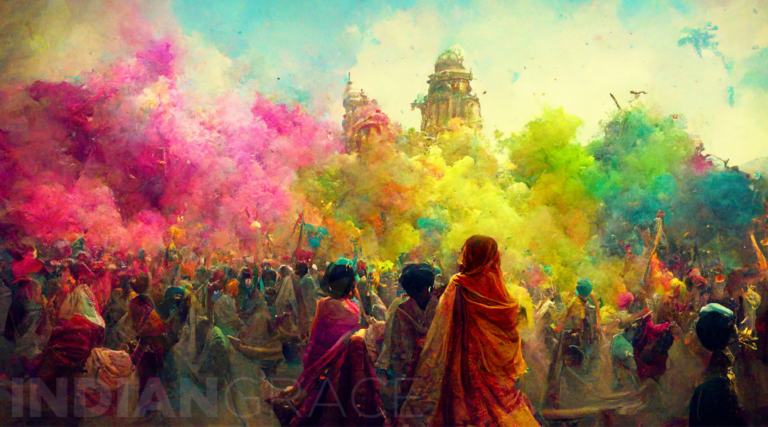Holi 2024: Have you ever wondered about the reason behind playing Holi with colors and why it is known as the festival of colors? Holi, the festival of colors, is celebrated with great enthusiasm and joy as people apply colors and gulal to each other. The secret behind this tradition is waiting to be revealed.

Holi 2024
Holi, the vibrant festival of colors, enchants the souls of countless individuals in India and beyond. It represents the triumph of good over evil, the onset of spring, and the infusion of joy into life. This lively celebration is an opportunity for loved ones to gather, splash each other with colors, and revel in the sense of togetherness and bliss. The preparations for this two-day extravaganza kick off weeks in advance, with streets decked out in colorful decorations and markets bustling with vendors peddling colored powder (gulal), water guns, and sweets.
Holi 2024 date and time
Get ready to celebrate Holi in style! The perfect time to immerse yourself in the vibrant festivities is from 7.19 pm to 9.38 pm on March 24. And guess what? The fun doesn’t stop there! On the following day, March 25, you can joyfully play Holi with your loved ones, smearing colors on your friends and family members. Let the colorful extravaganza begin!
Holi 2024 Celebration Date
Holi, a festival celebrated according to the Hindu calendar, marks the end of the month of Phalgun. The initial day of the festival involves lighting bonfires to symbolize the burning of the demon Holika, and it takes place on the evening of the full moon.
Following this, the next day is known as Padwa or the first day of the Hindu month Chaitra, when people engage in playing Holi.
In the Gregorian calendar, these events will fall on March 24 (Sunday) and 25 (Monday).
Way to celebrate Holi
To kick off Holi celebrations, a stack of wood is honored on day one, then set ablaze to represent the triumph of good over evil. Essential items for the ritual include raw cotton thread, coconut, colorful gulal powder, vermillion, rice grains known as akshat, incense sticks, fragrant flowers, batasha sweets, turmeric, and a bowl of water.
During the ‘Holika Dahan’ ceremony, a wooden pile is encircled three or seven times with raw cotton thread. Following this, Ganga water, flowers, and vermillion are sprinkled on it. The structure is then revered with garland, roli, akshat, batasha, turmeric, gulal, and coconut.
How to Celebrate Holi?
Holi morning brings a buzz of joy and laughter as crowds come together in parks, streets, and open areas to celebrate with colors and camaraderie. The festival breaks down social barriers, uniting people from different backgrounds in a spirit of warmth and affection. It’s a day where strangers become friends, and past grievances are forgotten in the midst of laughter and merriment.
Holi is not only about vibrant colors, but it also brings with it the opportunity to savor mouthwatering delicacies. Gujiya, a delectable dumpling filled with creamy khoya, and thandai, a rejuvenating beverage infused with nuts and aromatic spices, are some of the classic treats relished during this festive occasion.
Lord Krishna is closely associated with the significance of colors.
Holi, the festival of colors, holds a special significance in the city of Braj, which is closely associated with Lord Shri Krishna. This vibrant festival is celebrated with immense enthusiasm and attracts a multitude of tourists from both within the country and abroad. According to legends, the tradition of playing with colors during Holi was introduced during Lord Krishna’s time in the Dwapar era. Lord Shri Krishna, revered as a symbol of love, marks the commencement of Holi festivities by adorning himself with colors.
Legend has it that Lord Krishna would often ask his mother Yashoda why Radha was fair while he was black. Yashoda would simply laugh and avoid answering his question. One day, Krishna insisted that his mother tell him the reason behind Radha’s fairness. Yashoda then suggested that if Krishna applied color to Radha’s face, her complexion would become like his. Upon hearing this, Lord Krishna took colors and applied them to Radha’s face.
When Kanha ji appeared, the residents of Braj joyfully smeared colors on each other. This beautiful tradition originated in Vrindavan and Gokul, eventually evolving into a communal celebration of Holi. Legend has it that this custom of applying colors on Holi day began there. Another belief is that, once colored, people transcend social barriers of class and wealth, uniting as equals. This is why Holi is known as a festival symbolizing love and harmony.
FAQ About Holi
What is the real date of Holi in 2024?
In 2024, the festival of Holi will take place on 25th March throughout the nation. The festivities of Holi usually span over a period of 2 days – Holika Dahan on 24th March and the colorful celebrations on 25th March.
What are the 2 days of Holi?
Gujarat celebrates Holi as a two-day festival. The first day starts with a bonfire where raw coconut and corn are offered to the fire. The second day is known as “Dhuleti” and is all about the festival of colors, where people sprinkle colored water and apply colors to each other.
Is Holi on Purnima?
Holi is typically observed in late February or early March in the Gregorian calendar, signifying the beginning of spring and the conclusion of winter, aligning with the full moon or Purnima during the evening of the Hindu month of Phalguna.
What is the old name of Holi?
Holi, an ancient festival in India, was once referred to as “Holika”. Throughout history, this celebration has been depicted in various scriptures, including Jaimini’s Purvamimamsa-Sutras and Kathaka-Grhya-Sutras, as well as in detailed accounts found in texts like the Narad Purana and Bhavishyad Purana.